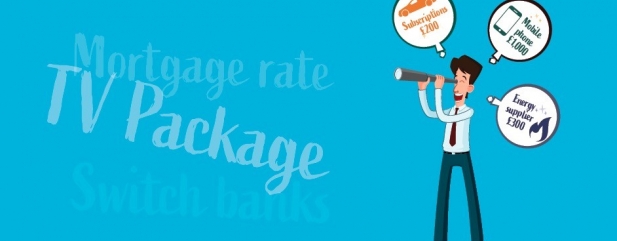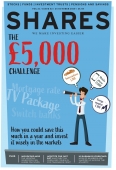Archived article
Please note that tax, investment, pension and ISA rules can change and the information and any views contained in this article may now be inaccurate.
The £5,000 challenge

Are you ready to take on the £5,000 challenge? It’s an annoying admin task that most feel like isn’t worth the hassle of dealing with, but cutting the cost of your monthly bills can lead to a tidy pot saved – and an even bigger pot if you invest these savings prudently in the markets.
The Government has been focusing on the so-called ‘loyalty penalty’ this year, whereby loyal customers who don’t hunt around for a better deal each year are charged more than new customers. Citizen’s Advice says the loyalty penalty costs consumers £2.9bn each year, and that’s only across five areas: mobile, broadband, home insurance, mortgages and savings.
If you’re someone who doesn’t regularly shop around each time a contract needs renewing, offer period ends or savings rate matures you could be paying way over the odds. This is particularly the case when you include other areas, such as your TV package, your gym membership or other subscriptions you have.
So where can you save the most?
Cancel your unwanted suscriptions
Lots of people have subscriptions they signed up to that they no longer use, or even ones they never intended to pay for. Most of us have fallen victim to signing up for a free trial to something and then forgetting to cancel before the trial period ended – Amazon Prime is a regular culprit.
The Citizens Advice Bureau estimates that the average Brit spends £640 a year on unwanted subscriptions, and some people don’t even realise they are paying for them. Check your bank accounts, including any old accounts you think you no longer use, and cancel anything you don’t use, don’t need or don’t want.
Saving: Around £640 a year
Switch energy supplier
Lots of people keep meaning to hunt for a better deal but never get around to it. The Government estimates that the average household could save £300 or more by switching, particularly if you’ve fallen on your energy provider’s Standard Variable Tariff, which is usually the most expensive rate.
Around half of UK households are on these standard tariffs, so the chances are high that this includes you. Get your recent energy bill and go to a comparison site, which will work out the best deal based on your usage.
Savings: On average £300
Get a cheaper phone bill
Lots of people sign up to a new monthly phone contract to get a new handset, but forget to switch once they’ve reached the end of that contract and paid off the cost of the handset. This means you’re paying a higher cost for no extra benefit. Also, when you come to renew each year or two, do you really need the latest handset or will your current one last another year?
If your phone still works then you can keep it and switch to a SIM-only contract, which means you just pay for the monthly plan and not the phone. This is far cheaper than signing up to get a new handset. For example, Vodafone has a £8 a month SIM-only deal with 4GB of data if you sign up for 12 months, while the latest iPhone 11 will cost you £63 a month with unlimited of data on a 24-month contract, and a £9 upfront cost. If you went for the slightly older iPhone 8 you’d pay £40 a month for 24 months, plus £19 a month upfront.
Savings: Based on the two options above, you’d save £1,329 or £787 a year by going SIM-only
Get a new mortgage rate
The average person on a two-year fixed rate mortgage is paying £439 a year too much, but 10% of people are paying more than £1,000 a year too much, according to Citizens Advice. This is because people sign up to a fixed rate deal and when that expires they move on to their provider’s Standard Variable Rate, which will be at a much higher interest rate.
The impact of this is seen in your monthly repayments, and will have a bigger impact the larger your mortgage. But it will also have a big impact on the total amount you repay over the 20 or 30-year term of your mortgage.
Switching your mortgage is a biggie, in terms of hassle. You’ll need to go through a full affordability assessment and apply for a new mortgage, perhaps with a new provider if they are offering the best rate. However, in terms of cost per minute of hassle, there’s the potential to save a lot too.
For example, a current top two-year fixed rate mortgage from Natwest has an interest rate of 1.4%, based on an 80% loan-to-value and a £200,000 loan over 25 years, but the Standard Variable Rate is 4.24%. On the fixed-rate deal you’d pay £790.51 a month, but on the SVR you’d pay £1,082.36 a month. In this example that means you’ve be paying out more than £3,500 a year more. At that level of saving it’s surely worth consideration.
Savings: Very specific to your mortgage amount and current rate, but potentially thousands
Switch savings – and bank account
Savings rates are so low at the moment that many people don’t think it’s worth switching to a better deal. But the chances are that if you’ve had your account for more than a year you’ve fallen onto your bank’s measly standard rate. If you’ve got a lot of cash savings you can make a decent amount more money by getting a to rate account.
The top easy-access account is from Marcus by Goldman Sachs, paying 1.45%. If we assume your cash savings are getting just 0.1% at the moment – although it could be less – on £10,000 of cash that equates to a gain of £140 a year.
You can get higher rates than this, albeit usually on smaller sums. M&S Bank pays 5% on its regular saver account, and you can pay in up to £250 a month, while Nationwide pays 5% on up to £2,500 in its FlexDirect current account.
Another option is to switch your current account to make free money. Banks will pay you an incentive to switch to them – HSBC is currently top with £175 of free cash. Each account will have specific requirements in order to get the free money, so make sure you stick to them. However, once you’ve met the requirements, stayed for the required amount of time and got your free cash, there’s nothing to stop you switching again.
Savings: £175 for switching account, and potentially hundreds of pounds depending on your cash savings
Cancel your pricey TV package
People who have been with Sky or Virgin Media for a number of years will have seen their costs creep up. For those wedded to keeping the service, you can call up to negotiate a new deal, and it’s likely you’ll instantly save money. Often a new deal will mean signing up to a new contract for a year, or more, but you’ll usually be able to cut your costs. You should also consider whether you’re using all the services and channels you’re paying for or whether it’s worth scaling down your package.
Another option is to ditch the service altogether and sign up to a streaming service, like Netflix or Amazon Video, and rely on that and Freeview. The cheapest membership for Netflix is £5.99 a month, so you could save a lot. Now TV is another option, as it has a lot of the series that are on Sky but you can buy a monthly pass and then turn it off when you no longer need it. The Entertainment pass, giving access to boxsets, costs £7.99 a month, while the Cinema Pass is £9.99 a month.
Savings: Varies. As an example, if you go from paying £80 a
month for Sky to £8 for Now TV, you’d save £984
What do I do with my savings?
Now if you take all the money you’ve saved in a year and make sure you invest it (rather than splurge it), how much could you make? Let’s assume you’ve saved £5,000 – it will clearly vary depending on the individual, but based on the above this isn’t unattainable for some.
If you invested that £5,000 and assume it grew at 5% a year after fees, you’d end up with almost £10,400 after 15 years, and almost £13,300 after 20 years. After 30 years your pot would have grown to more than £21,600.
Let’s also assume that you do this finances overhaul every five years and save this amount each time. In that instance, after 20 years you’d have just shy of £39,500 in your investment pot – having paid in £20,000 over that period. After 30 years you’d have more than £62,000, based on contributing £25,000 over that period.
What could I invest in?
A return of 5% means taking on some risk but a selection of good quality funds should do the trick. All three of these collectives have delivered annualised returns of comfortably more than 5% over the last three years. While past performance is not always a reliable guide to the future, these funds look to have a reasonable chance of achieving the targeted return of 5% after fees.
First State Global Listed Infrastructure (B24HK55)
Three-year annualised return: 7.8%
Infrastructure, think everything from roads to railways to electricity pylons, has attractions as an asset class in that it is uncorrelated from stocks and shares and offers consistent long-term yields. This collective, steered by experienced managers Peter Meany and Andrew Greenup, invests in listed infrastructure firms, an approach that marks it out from lots of funds in this space which invest directly in infrastructure assets. This potentially offers greater diversification and less volatility. Top holdings include the East Japan Railway Company and US mobile phone mast business Crown Castle.
Franklin UK Mid Cap (B7BXT54)
Three-year annualised return: 12.3%
This fund has a disciplined investment process which it applies largely to investing in mid cap FTSE 250 companies. This part of the market has performed well over the long term, comprising largely of established businesses which generate revenue and cash flow but which are not so big they don’t have room to grow. Managers Paul Spencer, Mark Hall and Richard Bullas use their own valuation tools and growth forecasting to identify quality companies trading at realistic levels and with robust balance sheets.
Man GLG Undervalued Assets (BFH3NB8)
Three-year annualised return: 9.7%
This fund has performed well despite the market showing a clear bias in recent years towards rewarding growth rather than looking for value. A recent shift in emphasis towards stocks which are perceived to be undervalued could provide a helpful backdrop for managers Henry Dixon and Jack Barrat. The pair look to identify stocks which either trade below the value of their assets or where their future profit and revenue is being underestimated. Prospective investors should be aware that the portfolio contains tobacco and oil and gas stocks, including British American Tobacco (BATS) and BP (BP.).
Important information:
These articles are provided by Shares magazine which is published by AJ Bell Media, a part of AJ Bell. Shares is not written by AJ Bell.
Shares is provided for your general information and use and is not a personal recommendation to invest. It is not intended to be relied upon by you in making or not making any investment decisions. The investments referred to in these articles will not be suitable for all investors. If in doubt please seek appropriate independent financial advice.
Investors acting on the information in these articles do so at their own risk and AJ Bell Media and its staff do not accept liability for losses suffered by investors as a result of their investment decisions.

 magazine
magazine
















